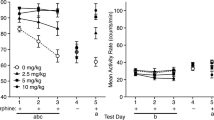Abstract
Tolerance to morphine analgesia (tail-immersion test) was examined after manipulation of two aspects of a tolerance test: 1) the route of drug administration and 2) the time interval between the test dosing and the tolerance test. The intravenous (IV) and intraperitoneal (IP) routes were used, together with a novel test for tolerance in which the test morphine was infused IV just 2 min before measuring the opiate effect. The first experiment validated this test as an assay for tolerance by examining the log dose-response (LDR) curve changes produced by daily IP injection with 0, 20 or 200 mg/kg morphine; the IV test confirmed the expected parallel shift to the right and flattening of the LDR curve. In the second experiment, all rats of two groups were injected once daily for 3 weeks with 20 mg/kg morphine and with saline except that one group received the morphine IV (and saline IP), the other morphine IP (saline IV). The results indicated route-specific tolerance. On a test using 20 mg/kg given IV morphine, tolerance was significantly greater in rats treated with IV morphine than in those treated IP. However, a larger effect on tolerance was produced by a pretest application of 5 mg/kg morphine 30 min before the actual tolerance test. This manipulation was designed to “prime” short-term, adaptive processes hypothesized to occur within a normal tolerance test session as morphine is taking effect. The tolerance on the test increased (equivalent to 2 to 3 fold shift in the LDR curve) when the pretest morphine was given with the same route as the chronic morphine, regardless of treatment group. It was concluded that opiate tolerance may be modulated by conditioned stimuli produced by morphine acting through different routes. These interoceptive cues appear to modulate rapidly acquired and short-lived adaptive processes taking place within a given test session.
Similar content being viewed by others
References
Ádám G (1967). Interoception and behavior: an experimental study. Akadémiai Kiadó, Budapest
Bechara A, Vanderkooy D (1985) Opposite motivational effects of endogenous opioid in brain and periphery. Nature 314:533–534
Cepeda-Benito A, Tiffany ST (1993) Morphine as a cue in associative tolerance to morphine's analgesic effects. Pharmacol Biochem Behav 46:149–152
Dafters RI, Odber J, Miller J (1988) Associative and non-associative tolerance to morphine: support for a dual-process habituation model. Life Sci 42:1897–1906
Goudie AJ, Emmett-Oglesby MW (1989). Tolerance and sensitization: overview. In: Goudie AJ, Emmett-Oglesby MW (eds) Psychoactive drugs: tolerance and sensitization. Humana, Clifton, NJ, pp 1–13
Greeley J. Le AD Poulos CX, Cappell H (1984) Alcohol is an effective cue in the conditional control of tolerance to alcohol. Psychopharmacology 83:59–162
Grisel IE, Wiertelak EP, Watkins LR, Maier SF (1994). Route of morphine administration modulates conditioned analgesic tolerance and hyperalgesia. Pharmacol Biochem Behav 49:1029–1035
Kalant H, LeBlanc AE, Gibbons RJ (1971) Tolerance to, and dependence on, some nonopiate psychotropic drugs. Pharmacol Rev 23:135–191
Lange DG, Roerig F, Fujimoto JM, Busse LW (1983) Withdrawal tolerance and unidirectional non-cross-tolerance in narcotic pellet-implanted mice. J Pharmacol Exp Ther 224:13–20
LeBlanc AE, Kalant H, Gibbins RJ (1975) Acute tolerance to ethanol in the rat. Psychopharmacologia 41:43–46
Mackintosh NJ (1983) Conditioning and associative learning. Clarendon Press, Oxford
Martin WR, Eades CG (1961) Demonstration of tolerance and physical dependence in the dog following a short-term infusion of morphine. J Pharmacol Exp Ther 133:262–270
Martin WR, Fraser HF (1961) A comparative study of physiological and subjective effects of heroin and morphine administered intravenously in postaddicts. J Pharmacol Exp Ther 133:388–399
McLaughlin CR, Lichtman AH, Fanselow MS, Cramer CP (1989) Pro-Leu-Gly-NH2 serves as a conditioned stimulus in the acquistion of conditioned tolerance. Behav Neurosci 103:447–451
Montoya P, Schandry R, Müller A (1993) Heartbeat evoked potentials (HEP): topography and influence of cardiac awareness and focus of attention. Electroencephalogr Clin Neurophysiol 88:163–172
Mucha RF (1989) Taste aversion involving central opioid antagonists is potentiated in morphine-dependent rats. Life Sci 45:671–678
Mucha RF, Kalant H (1980) Log dose/response curve flattening in rats after daily injection of opiates. Psychopharmacology 71:51–61
Mucha RF, Niesink R, Kalant H (1978) Tolerance to morphine analgesia and immobility measured in rats by changes in logdose-response curves. Life Sci 23:357–364
Mucha RF, Vanderkooy D, O'Shaughnessy M, Bucenieks P (1982) Drug reinforcement studied by use of place conditioning in rat. Brain Res 243:91–105
Mucha RF, Kalant H, Kim C (1987) Tolerance to hyperthermia produced by morphine in rat. Psychopharmacology 92:452–458
Osborne R, Joel S, Trew D, Slevin M (1990) Morphine and metabolite behavior after different routes of morphine administration: demonstration of the importance of the active metabolite morphine-6-glucuronide. Clin Pharmacol Ther 47:12–19
Poulos CX, Hunt T, Cappell H (1988) Tolerance to morphine is reduced by the novel addition or omission of an alcohol cue. Psychopharmacology 94:412–416
Radlow R (1994) A quantitative theory of acute tolerance to alcohol. Psychopharmacology 114:1–8
Siegel S (1975) Evidence from rats that morphine tolerance is a learned response. J Comp Physiol Psych 89:498–506
Siegel S (1988) State dependent learning and morphine tolerance. Behav Neurosci 102:228–232
Siegel S, Hinson RE, Krank MD, McCully J (1982) Heroin “overdose” death: contribution of drug-associated environmental cues. Science 216:436–437
Author information
Authors and Affiliations
Rights and permissions
About this article
Cite this article
Mucha, R.F., Kalant, H. & Birbaumer, N. Loss of tolerance to morphine after a change in route of administration: control of within-session tolerance by interoceptive conditioned stimuli. Psychopharmacology 124, 365–372 (1996). https://doi.org/10.1007/BF02247442
Received:
Revised:
Issue Date:
DOI: https://doi.org/10.1007/BF02247442




